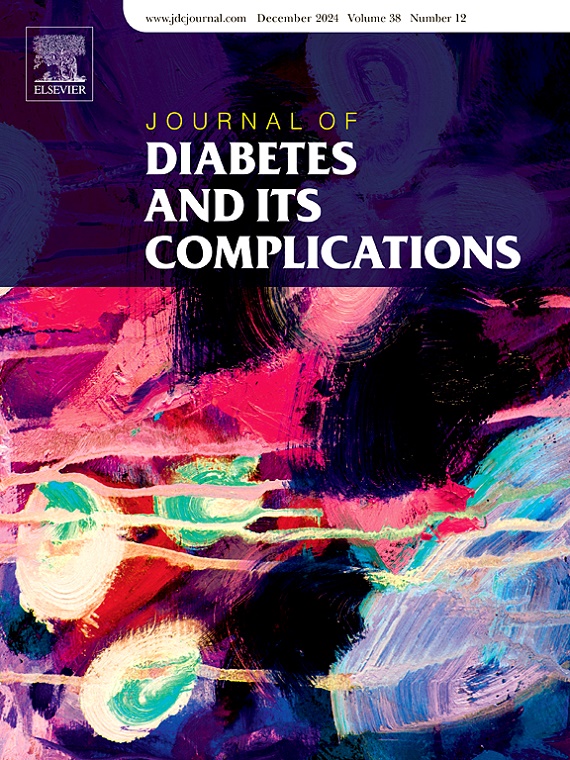Progress in the treatment of vascular complications in type 2 diabetes by finerenone in combination with RAS inhibitors/SGLT-2i
IF 2.9
3区 医学
Q3 ENDOCRINOLOGY & METABOLISM
引用次数: 0
Abstract
Background
Currently, the prevalence of diabetes is rising. Patients with diabetes often face high risks of kidney disease, cardiovascular disease, and retinal disease. Cardiovascular complications are the primary cause of morbidity and mortality in patients with type 2 diabetes mellitus. Finerenone is a novel non-steroidal mineralocorticoid receptor antagonist. Research has shown that finerenone provides renal, cardiac, and retinal protection in patients with type 2 diabetes. Currently, various drugs (angiotensin-converting enzyme inhibitors, angiotensin II receptor antagonists, sodium-glucose co-transporter 2 inhibitors) are effective in treating diabetic vascular complications, but each has its limitations. Combining finerenone with RAS Inhibitors/SGLT-2i may yield better clinical outcomes.
Methods
This review aggregates research on the mechanisms and clinical efficacy of finerenone, RAS Inhibitors, and SGLT-2i used individually, as well as in combination, for the treatment of vascular complications in diabetes from various databases.
Results
This review shows that combining finerenone with RAS inhibitors/ SGLT-2 inhibitors can further reduce proteinuria, the urinary albumin-to-creatinine ratio, and the risk of hyperkalemia, slow CKD progression, reduce atherosclerosis, myocardial fibrosis, and hypertrophy, and lower the incidence of atrial fibrillation, myocardial infarction, and heart failure. It can also reduce retinal neovascularization, macular edema, and inflammation. Overall, combining can further lower the risk of complications in type 2 diabetic patients.
Conclusions
In summary, combining finerenone with RAS inhibitors and SGLT-2i is a promising treatment strategy. However, the molecular mechanisms and interactions are not fully understood, necessitating more basic research and clinical trials to provide evidence. Combining finerenone with existing treatments may yield better clinical outcomes.
细烯酮联合RAS抑制剂/SGLT-2i治疗2型糖尿病血管并发症的研究进展
当前,糖尿病的患病率呈上升趋势。糖尿病患者经常面临肾脏疾病、心血管疾病和视网膜疾病的高风险。心血管并发症是2型糖尿病患者发病和死亡的主要原因。芬烯酮是一种新型的非甾体皮质激素受体拮抗剂。研究表明,芬烯酮对2型糖尿病患者的肾脏、心脏和视网膜具有保护作用。目前,多种药物(血管紧张素转换酶抑制剂、血管紧张素II受体拮抗剂、钠-葡萄糖共转运蛋白2抑制剂)可有效治疗糖尿病血管并发症,但各有其局限性。芬烯酮联合RAS抑制剂/SGLT-2i可能会产生更好的临床结果。方法本综述汇总了来自不同数据库的细芬烯酮、RAS抑制剂和SGLT-2i单独或联合使用治疗糖尿病血管并发症的机制和临床疗效的研究。结果本综述显示,芬烯酮联合RAS抑制剂/ SGLT-2抑制剂可进一步降低蛋白尿、尿白蛋白与肌酐比,降低高钾血症风险,减缓CKD进展,减少动脉粥样硬化、心肌纤维化和肥厚,降低房颤、心肌梗死和心力衰竭的发生率。它还可以减少视网膜新生血管、黄斑水肿和炎症。总的来说,联合用药可以进一步降低2型糖尿病患者并发症的风险。综上所述,芬烯酮联合RAS抑制剂和SGLT-2i是一种很有前景的治疗策略。然而,分子机制和相互作用尚不完全清楚,需要更多的基础研究和临床试验来提供证据。将芬烯酮与现有的治疗方法结合可能会产生更好的临床效果。
本文章由计算机程序翻译,如有差异,请以英文原文为准。
求助全文
约1分钟内获得全文
求助全文
来源期刊

Journal of diabetes and its complications
医学-内分泌学与代谢
CiteScore
5.90
自引率
3.30%
发文量
153
审稿时长
16 days
期刊介绍:
Journal of Diabetes and Its Complications (JDC) is a journal for health care practitioners and researchers, that publishes original research about the pathogenesis, diagnosis and management of diabetes mellitus and its complications. JDC also publishes articles on physiological and molecular aspects of glucose homeostasis.
The primary purpose of JDC is to act as a source of information usable by diabetes practitioners and researchers to increase their knowledge about mechanisms of diabetes and complications development, and promote better management of people with diabetes who are at risk for those complications.
Manuscripts submitted to JDC can report any aspect of basic, translational or clinical research as well as epidemiology. Topics can range broadly from early prediabetes to late-stage complicated diabetes. Topics relevant to basic/translational reports include pancreatic islet dysfunction and insulin resistance, altered adipose tissue function in diabetes, altered neuronal control of glucose homeostasis and mechanisms of drug action. Topics relevant to diabetic complications include diabetic retinopathy, neuropathy and nephropathy; peripheral vascular disease and coronary heart disease; gastrointestinal disorders, renal failure and impotence; and hypertension and hyperlipidemia.
 求助内容:
求助内容: 应助结果提醒方式:
应助结果提醒方式:


